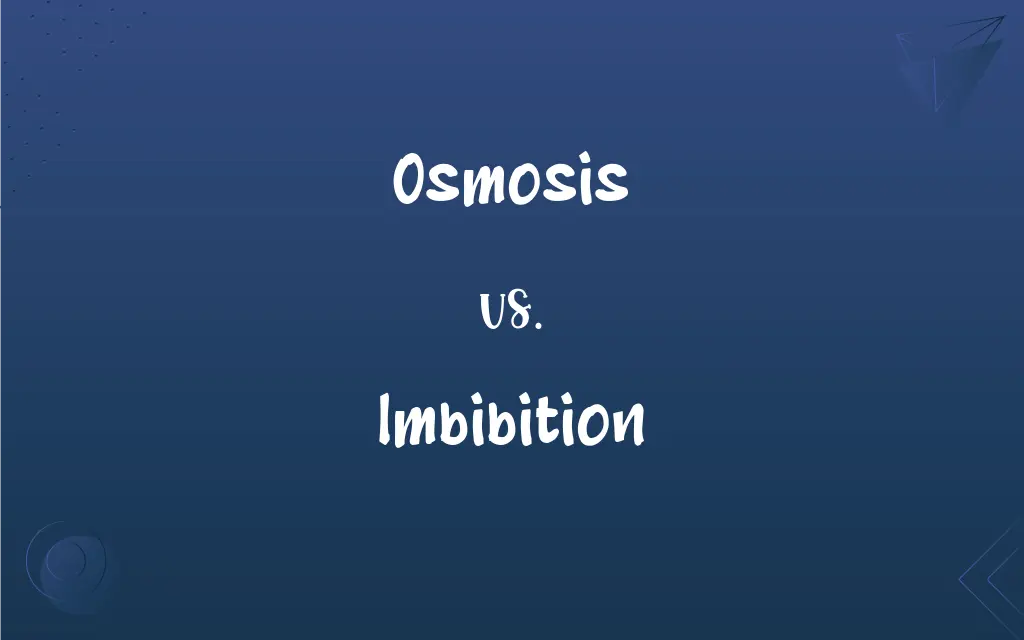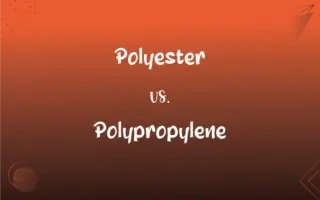Osmosis vs. Imbibition: What's the Difference?
Edited by Janet White || By Harlon Moss || Updated on October 26, 2023
Osmosis is the diffusion of water across a semipermeable membrane, while imbibition is the absorption of water by solids.

Key Differences
Osmosis and imbibition are both water movement processes, but osmosis involves a semipermeable membrane while imbibition doesn't.
Osmosis is a selective process, allowing only water molecules to pass through the membrane. Imbibition involves water being absorbed by porous solids.
In osmosis, water moves from a region of low solute concentration to high concentration. Imbibition occurs when water is drawn into a dry substance.
Osmosis is crucial in biological systems for maintaining cell turgidity. Imbibition is essential for processes like seed germination.
Both osmosis and imbibition are vital for plant life, but osmosis primarily occurs within cells, while imbibition happens at the initial stage of water uptake.
ADVERTISEMENT
Comparison Chart
Involvement of Membrane
Requires a semipermeable membrane
No membrane involved
Movement Direction
From lower to higher solute concentration
Into porous solids
Biological Role
Maintains cell turgidity
Initiates processes like seed germination
Mechanism
Selective diffusion of water
Absorption of water by solids
Dependency
Depends on solute concentration gradient
Depends on the porosity of the solid
ADVERTISEMENT
Osmosis and Imbibition Definitions
Osmosis
Diffusion of water across a semipermeable membrane.
Osmosis is why plant roots absorb water from the soil.
Imbibition
No membrane involved in the process.
Imbibition happens when seeds absorb water.
Osmosis
Selective process in biological systems.
Osmosis allows cells to regulate their internal environment.
Imbibition
Initiates seed germination.
Imbibition is the first step in a seed sprouting.
Osmosis
Movement from lower to higher solute concentration.
Osmosis explains why raisins swell in water.
Imbibition
Absorption of water by solids.
Imbibition causes dry sponges to expand in water.
Osmosis
Maintains cell turgidity.
Osmosis keeps plant cells firm and upright.
Imbibition
Relies on the porosity of solids.
Imbibition is more effective in highly porous materials.
Osmosis
Depends on concentration gradient.
Osmosis occurs faster when there's a steep concentration gradient.
Imbibition
Involves water uptake by capillary action.
Imbibition explains why paper towels absorb spills.
Osmosis
Diffusion of fluid through a semipermeable membrane from a solution with a low solute concentration to a solution with a higher solute concentration. Osmosis ceases when there is an equal solute concentration on both sides of the membrane.
Imbibition
The act of imbibing.
FAQs
Why is imbibition important for seeds?
Imbibition enables seeds to absorb water, initiating germination.
What is osmosis?
Osmosis is the movement of water across a semipermeable membrane from a lower to a higher solute concentration.
How does osmosis differ from imbibition?
Osmosis involves a semipermeable membrane, while imbibition doesn't require a membrane.
What's the role of osmosis in cells?
Osmosis helps maintain cell turgidity and regulate internal conditions.
Can imbibition occur in any solid?
Imbibition mainly occurs in porous solids capable of absorbing water.
Does imbibition require a specific temperature?
While not highly temperature-dependent, warmer conditions can slightly accelerate imbibition.
Do osmosis and imbibition play roles in human health?
Yes, osmosis is vital in bodily functions, and understanding imbibition can aid in dietary fiber intake.
What is imbibition?
Imbibition is the absorption of water by solid substances, typically porous ones.
Does osmosis require energy?
Osmosis is a passive process and doesn't require external energy.
What factors influence the rate of osmosis?
Factors include membrane permeability, solute concentration, and temperature.
Is a concentration gradient necessary for osmosis?
Yes, osmosis depends on a solute concentration gradient.
Can osmosis occur in non-living systems?
Yes, osmosis can occur in any system with a semipermeable membrane and a solute concentration gradient.
How does temperature affect osmosis?
Higher temperatures can increase the rate of osmosis.
Can osmosis occur without water?
No, osmosis specifically refers to the movement of water.
Is imbibition reversible?
Imbibition can be partially reversible through drying, but not always completely.
How does imbibition benefit agriculture?
Imbibition is essential for seed germination, crucial in crop production.
Can imbibition occur in non-porous materials?
No, non-porous materials generally do not undergo imbibition.
What substances typically undergo imbibition?
Substances like seeds, sponges, and paper undergo imbibition.
Is imbibition a quick process?
The rate of imbibition varies but can be relatively quick in highly absorbent materials.
What are practical applications of osmosis?
Osmosis is used in water purification, food preservation, and medical treatments.
About Author
Written by
Harlon MossHarlon is a seasoned quality moderator and accomplished content writer for Difference Wiki. An alumnus of the prestigious University of California, he earned his degree in Computer Science. Leveraging his academic background, Harlon brings a meticulous and informed perspective to his work, ensuring content accuracy and excellence.
Edited by
Janet WhiteJanet White has been an esteemed writer and blogger for Difference Wiki. Holding a Master's degree in Science and Medical Journalism from the prestigious Boston University, she has consistently demonstrated her expertise and passion for her field. When she's not immersed in her work, Janet relishes her time exercising, delving into a good book, and cherishing moments with friends and family.































































